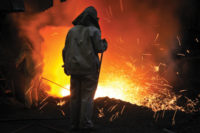1 Employee vs. company-sponsored laundering programs
The first step to establishing a maintenance program for protective clothing is deciding whether or not to institute a company-sponsored laundry program. A laundry program is essential if employees are working with toxic materials or in applications that leave apparel heavily soiled at the end of the day.
Plus, much of today’s high performance protective apparel comes with special care instructions. For example, cleaning products such as bleach or fabric softener can compromise or weaken the performance of flame-resistant (FR) clothing. In these cases, a company laundering program goes a long way in preventing injuries on the job and extending the life of garments by insuring the manufacturer’s laundering guidelines are followed to the tee. For company-sponsored laundry programs, discipline and communication are also essential. Employees must know when and where to leave their garments, and everyone must buy into the program.
2 In-house laundering vs. outsourced laundry service
Once you decide to institute a company laundering program, you must next choose between an in-house or outsourced laundering service. It might seem obvious that any company could save money by cutting out the middle-man and laundering their own clothes, but there are several factors to consider. Going in-house not only entails up-front costs for machinery and installation but also ongoing expenses such as maintenance, utilities, personnel and employee training.
There is also the question of space: could that area be better used to generate revenue for your company? If so, how much? Depending on your answer, outsourcing could be a viable cost-saving option.
Proper education and training is key to laundering work clothing in-house, particularly when washing flame-resistant (FR) garments. Using the wrong treatment can compromise performance, and certain cleaners and softeners can leave flammable residue on the garment. Stain elimination is crucial. Lingering stains from flammable materials such as oil and gas are susceptible to ignition, and can remain afire when a garment would otherwise self-extinguish. Thankfully, all FR garments that meet the ASTM F1506 standard are required to have detailed laundering guidelines. If there are any questions, you can also ask the manufacturer of the garment for clarification.
3 Renting vs. buying clothing
You can also choose to rent protective clothing. Oftentimes, the same company that provides the laundry service offers work clothing rental as well. Going this route eliminates the up-front cost of purchasing clothing and replaces it with a flat rental fee. “One-stop shops” that also launder clothing provide the added convenience of a single point of contact for multiple services. As with laundry, the decision to rent or buy clothing boils down to knowing your costs and choosing the option that maximizes savings.
4 Repairing vs. replacing damaged clothing
Implementing a replacement policy is another means for companies to enhance safety and save money. Fraying material is almost always the first sign that a garment needs to go. Stress areas such as joints, elbows and knees are usually the first areas to show wear, depending on the nature of the activity. It is important to have a clear, well-communicated company policy on when to replace and when to repair a piece of clothing.
When deciding whether to repair or replace protective clothing, you should define specific guidelines and parameters as to what seam tears or hole sizes qualify for repair. For instance, you could decide to repair all holes under two inches, and throw away any item with a hole over two inches. A visual aid such as a quarter can be handy for this, depending on what size you choose. Other factors to consider include the cost of the material, the time needed for repair and the expected remaining life of the garment. It probably does not make sense to repair a hole if the garment is already fraying in several other areas.
5 Treated vs. inherently flame-resistant (FR) garments
The care requirements for flame-resistant (FR) garments are much higher than those for everyday workwear and directly impact safety and spend. For instance, when repairing FR clothing, it is essential to patch using the same material as the garment itself and to sew using quality FR thread. Some treated FR fabrics lose their effectiveness after a certain number of washes. In that case, it is good to have a clear policy for tracking each garment’s launderings. Other treated materials such as arc-rated clothing and inherently-FR clothing are tested to retain their performance for the life of the garment. Choosing the best FR clothing option for your needs is contingent upon the expected service life of the garment. Both treated and inherently-FR garments can be viable cost-saving options depending on the cost per piece of each option and how fast your employees wear out their clothing.
Enlist the experts
All in all, employing an effective work clothing maintenance program can increase garment accountability and integrity and significantly reduce overall costs. In the process of instituting a company laundering program, safety managers should carefully evaluate the options available to them to tailor a plan to their unique work environment and safety culture. Enlist the support of the experts — your PPE and laundering service providers — to help you gather the data and make the most informed decisions.


